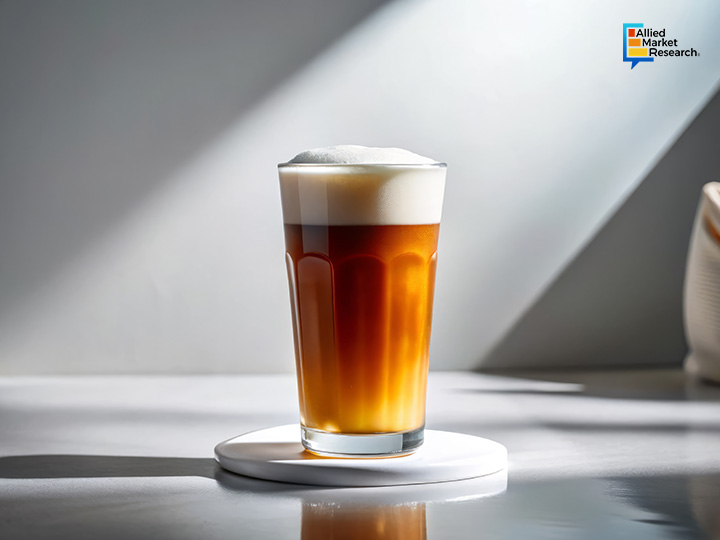Nitro Tea: Changing the Beverage Experience in Foodservice and Retail

24 Jun
2025
Highlights:
- Introduction
- Smooth & Creamy Texture
- Popular in Cafes & Stores
Nitro tea is not a brand-new drink, but it has become more noticeable in recent years, especially in cafes, restaurants, and ready-to-drink segments. It’s a type of cold-brew tea infused with nitrogen gas, giving it a smooth, creamy texture without adding milk or sugar. Though the drink may look like a novelty item on menus at first, businesses are now paying closer attention to how this product fits into larger trends in customer preferences and operational needs.
Understanding the Product
What makes nitro tea different from other teas is the infusion of nitrogen, which is a colorless and odorless gas. When added to cold-brew tea under pressure, nitrogen changes the texture and mouthfeel. The tea comes out of a tap with a frothy head, similar to a stout beer, and has a rich, smooth texture that makes it feel more indulgent than regular iced tea. The visual appeal of the cascading bubbles enhances the overall customer experience.
Most nitro teas are made from black or green tea, but many providers are now experimenting with herbal blends, oolong, or fruit infusions. These drinks are often served without ice to maintain the creamy foam at the top. Unlike sugar-loaded beverages, nitro tea is usually served unsweetened, which appeals to health-conscious consumers. This feature is helping businesses offer a product that matches current low-sugar or zero-additive preferences.
From a service perspective, nitro tea taps are usually installed in the same way as cold brew coffee systems, which allows cafes and restaurants to add this product without needing completely new equipment. It can be kegged and stored under refrigeration, making it easy to dispense and maintain consistent quality over time. This convenience is particularly useful in busy kitchens or high-volume cafes.
Retail and Café Operators Are Experimenting with Format
Nitro tea is being offered in two main formats: on-tap beverages for dine-in service and ready-to-drink cans for retail shelves. In both formats, nitrogen remains the key to both the texture and shelf appeal. For cafes, adding nitro tea to the menu brings a new category of beverage without adding significant labor. It can also be poured quickly during rush hours without brewing or mixing, saving time for baristas.
On the other hand, the canned version of nitro tea has gained visibility in retail fridges over the last two years. These cans are usually pressurized and contain a widget or nitrogen charge that creates the cascading effect when opened. This allows consumers to experience the same creamy texture outside the café setting. Since the process needs a pressurized container, many packaging manufacturers can't deal with it—making retail expansion challenging for producers.
In January 2025, several U.S.-based beverage companies, including Rise Brewing Co. and Sound, were reported to be exploring partnerships with packaging innovators to improve the shelf stability of nitro tea products. This comes at a time when several coffee brands have already made the leap into nitro beverages and are looking to diversify their offerings. The cold brew segment has already proven consumer interest in nitrogen-infused beverages, and tea producers are applying similar ideas to capture that attention. The nitro tea market accounted for $242.2 million in 2023 and is predicted to generate revenue share of $503.7 million by 2035, citing a CAGR of 6.3% during 2024-2035.
Challenges in Production and Supply Chain
Although nitro tea sounds simple, the process behind it involves several technical steps. First, the tea needs to be brewed cold, which takes several hours. Then, it has to be filtered and stored in sanitary containers. The nitrogen infusion process should be done under pressure and requires proper sealing. If these steps are not done properly, the nitrogen will not stay in the drink, and the final product can lose its creamy texture or freshness.
For foodservice businesses, maintaining consistent pressure in kegs and preventing leaks are common issues. Staff also need to be trained in handling the taps and storage units, which adds a minor but necessary step in service training. On the production side, there are also packaging challenges, especially with cans. Because nitrogen is a gas, it can expand and create pressure changes depending on temperature and altitude, which affects transport and storage. Some brands are currently testing alternative can linings and sealants to prevent leaks or flat pours.
What Today’s Customers Expect—and Why It Matters
The idea of tea as a fizzy, creamy drink is still relatively new in many regions. For foodservice and beverage businesses, it’s important that staff or clients know what sets nitro tea apart and how to explain it clearly to customers. Visual presentation plays a big role, so tap installations with clear display or staff-led tastings can help promote the new beverage in a low-cost way.
It is also important to note that nitro tea has been appealing not only to tea drinkers but also to coffee lovers looking for lighter alternatives. Since it offers a rich mouthfeel without caffeine overload or sugar, it fits well with daytime menus, brunch offerings, and health-focused beverage selections.
Some tea companies have started collaborating with fitness studios, wellness centers, and even co-working spaces to introduce nitro tea taps as a non-caffeinated hydration option. In February 2025, a Los Angeles-based brand teamed up with an urban gym chain to install nitro tea dispensers in their community zones, sparking conversation about how tea can serve both function and experience in non-traditional places.
Final Words
Nitro tea is no longer just an experimental beverage served at upscale cafes. It is becoming part of how businesses rethink tea-based products for a modern audience. With its smooth texture, low-sugar profile, and flexible formats, nitro tea offers both aesthetic and functional value to businesses. The technical aspects of production and packaging are still evolving, but the focus is on creating a beverage that feels fresh, familiar, and different all at once. Whether it’s served from a tap in a small café or cracked open in a ready-to-drink can at a co-working fridge, nitro tea has created space for tea to be experienced in new ways.
For detailed information on the investment opportunities in the industry, contact our experts here!

Koyel Ghosh
Author’s Bio- Koyel Ghosh is a blogger with a strong passion and enjoys writing in miscellaneous domains, as she believes it lets her explore a wide variety of niches. She has an innate interest in creativity and enjoys experimenting with different writing styles. A writer who never stops imagining, she has been serving the corporate industry for the last five years.
Avenue: Entire Library membership of Allied Market Research Reports at your disposal
- Avenue is an innovative subscription-based online report database.
- Avail an online access to the entire library of syndicated reports on more than 2,000 niche industries and company profiles on more than 12,000 firms across 11 domains.
- A cost-effective model tailored for entrepreneurs, investors, and students & researchers at universities.
- Request customizations, suggest new reports, and avail analyst support as per your requirements.
- Get an access to the library of reports at any time from any device and anywhere.
Related Post
-
How are Submarine Cables Transforming Global Connectivity with Enhanced User Experience?
-
Endoscopy Procedures: Transformations in Techniques and Applications
-
AI-Powered Video Analytics: How the Product Actually Works for enterprises
-
Painting Robots: Transforming Precision Coating and Creative Applications
-
Innovations in Pharmacovigilance Systems Advancing Patient Safety
-
Understanding Edge Security: Keeping Data Safe Near the Source
-
Exploring the Use and Advancements of 3D Laser Scanners in Professional Applications
-
Reinforcing Industrial Controls with Smarter Tools and Training








